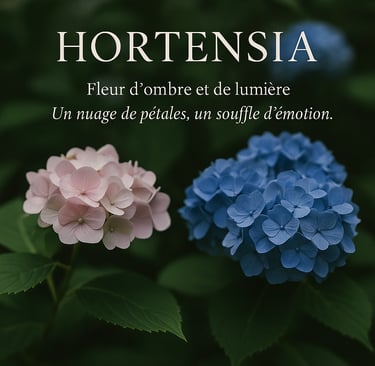Hydrangea: A Jewel of Nature
LES PLANTES
Hydrangea, known scientifically as Hydrangea, is a perennial plant cherished for both its beauty and its resilience.
A cloud-like flower: rounded or star-shaped
With its generous grace, the hydrangea unfolds in two distinct forms.
The most iconic is the mophead hydrangea, a soft, rounded cluster that looks almost fluffy—countless tiny florets gathered like a breath of childhood.
Beside it, the lacecap hydrangea offers a lighter dance: a center of fertile flowers surrounded by a halo of larger sterile blossoms, like butterflies resting on a quiet lake.
Two shapes, two expressions of the same floral spirit—oscillating between abundance and delicacy.
A shifting palette painted by the soil
Sky blue, candy pink, misty mauve or moon-white—the color of a hydrangea is a mystery that only the earth can reveal.
It is the soil’s acidity that plays the role of alchemist:
In acidic soil, it turns deep blue
In neutral to alkaline soil, it becomes soft pink or red
Some varieties remain white, untouched by the whims of pH
Hydrangeas thrive in cool, rich, well-drained soil, with a preference for partial shade—where the light softens its warmth.
A long, whispering bloom
Hydrangeas take the stage at the start of summer, often in June, and continue to bloom until September—sometimes later in mild climates.
Their flowering is a slow, poetic stretch, known for its remarkable longevity.
Even when dried, the flowers remain beautiful, dignified, and soft—perfect for preserving, or for being captured in resin like a fragment of eternal light.
Carry with you the secret of an endless summer—my dried hydrangea jewelry is poetry you can wear.
A rooted journey between two worlds
Native to East Asia—especially Japan, China, and Korea—the hydrangea conquered European gardens in the 18th century.
It also thrives along the Atlantic coast of France, in Brittany and the Basque Country, where it grows freely, blooming at the bend of stone walls and shaded paths.
Beautiful… but not for eating
Though enchanting to the eye, hydrangeas must never tempt the palate.
Every part of the plant—leaves, flowers, stems—is toxic to humans.
Accidental ingestion or homemade infusions can cause digestive and neurological issues.
Animals face the same risk: horses, dogs, cats, and cattle should be kept away.
While hydrangeas do not harm the soil, their presence can be problematic for farmers, and they should not grow near grazing areas.
What hydrangeas whisper — Symbolism and meaning
Hydrangeas are deeply symbolic flowers, stirring the imagination and human emotion.
In the language of flowers, they are associated with gratitude, heartfelt emotions, love, and understanding.
To offer hydrangeas is to express profound feelings toward someone.
Wearing a hydrangea—even preserved within a drop of resin—is to carry a nuanced emotion, a floral memory that whispers to the soul.
A shimmer of hydrangea, a fragment of emotion
Discover my handcrafted creations and keep the beauty of flowers close to your heart.


French craftsmanship
Copyright©2025 Créa'Bohème
